Original Author: Elliot Hershberg
Translation: LlamaC
Main Text?
Ten years ago, Bob Duggan, a believer in the scientific school (not a scientist), sold his American biotechnology startup for $21 billion (yes, not million) to AbbVie. His company, Pharmacyclics, developed a promising cancer drug and reaped substantial rewards as a result. In fact, it has been reported that Duggan's earnings of over $3.5 billion are among the most lucrative in the history of public acquisition cases.
Aside from the eccentricity of founder Duggan—and the involvement of several other big names that made the whole event historic—this was originally a relatively ordinary transaction. A large pharmaceutical company was under immense pressure to find new sources of revenue as the patent exclusivity period for one of its blockbuster products was about to expire. Meanwhile, a breakthrough drug from an American startup happened to fill that gap.
A significant portion of the biotechnology industry is built on this dynamic. Small startups have become the primary source of innovation, taking on most early clinical trials each year. Large pharmaceutical companies acquire these startups at hefty premiums to continuously replenish their product pipelines.
But the situation is changing. A decade later, Duggan is making a comeback. This time, he brings a new drug that has outperformed Merck's $30 billion cancer immunotherapy drug Keytruda in clinical trials. The key point is that Duggan did not discover this drug in an American lab; rather, he obtained the license from a Chinese company.
Unlike Pharmacyclics, this story did not end with a multi-billion dollar acquisition. Instead, Merck turned to the same source and purchased its own version of a similar drug from another Chinese company for $500 million.
This is significant. As we have recently seen in the field of artificial intelligence, China has become a formidable competitive threat in the biotechnology sector, demonstrating a rapid ability to develop new drugs that can rival—and even surpass—products from American labs. In other words, "the pharmaceutical industry is entering its 'deepseek moment.'"
Another example: With the explosive success of GLP-1 class drugs, pharmaceutical companies are racing to acquire their next generation of such products to compete with Novo Nordisk and Eli Lilly for market share. Merck again turned its gaze to China, acquiring an oral GLP-1 drug for $112 million upfront. The deal also includes subsequent milestone payments based on commercial success, totaling $1.9 billion.
For context, American biopharmaceutical company Viking Therapeutics has an oral GLP-1/GIP agonist in its development pipeline, currently valued at $3.8 billion. Instead of fully acquiring Viking, why not obtain a molecule from China at a lower price and see if it works?
At a time when the biotechnology market is sluggish, intensified external competition has made matters even more difficult. While the M&A market has slowed, founders and investors are now losing sleep over those obscure Chinese competitors they have never heard of, who are sabotaging deals at the last minute.
The entire situation has sparked a flurry of analysis. So far, my favorite reflections include those from David Li, a founder of a Chinese-American biotechnology startup, his follow-up analysis in the Timmerman Report, Bloomberg's coverage, and Alex Telford's thoughtful insights on the question, "Will all our drugs come from China?"
Here, I want to take a step back and think about how we got to this point.
In 1987, Merck graced the cover of Fortune magazine for "betting on a magic molecule," being named "America's Most Admired Company."
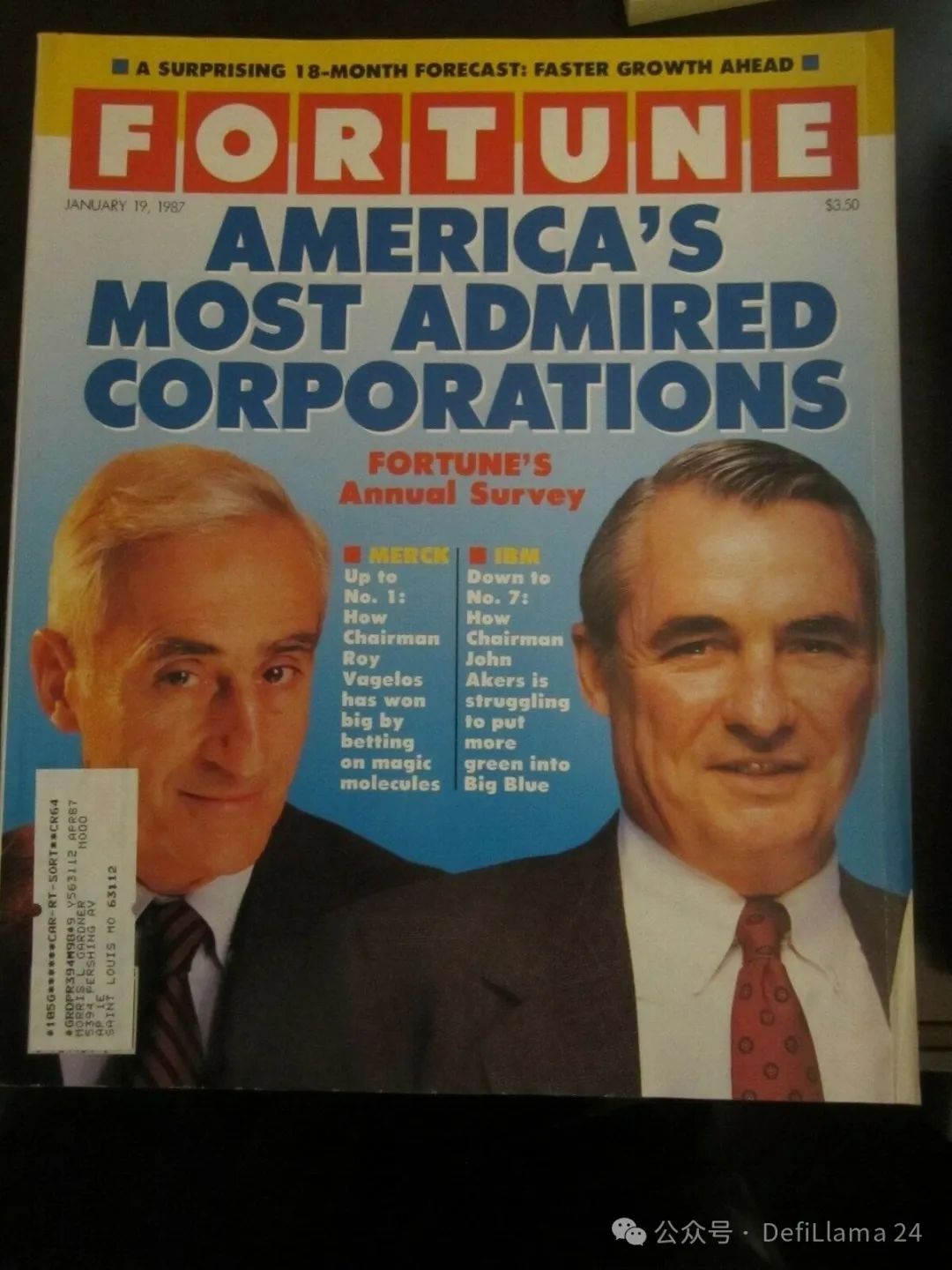
For decades prior, Merck's scientists were responsible for developing breakthrough molecules for hypertension, some of the most successful vaccines in history (one of the highest-grossing vaccinologists, Maurice Hilleman, was a Merck scientist), the first statins, and entirely new classes of antibiotics.
Today, for the two hottest products on the market, Merck is not relying on the American biotechnology startup ecosystem (which was still in its difficult infancy in 1987) but is sourcing molecules from the Chinese ecosystem—only recently has China become an important source of innovation.
Clearly, the global drug development industry has undergone a significant evolution. At this juncture, I believe it is necessary to reflect on the long journey of the commercialization of drug development technologies and the implications of this historical pattern for the future of the industry.
The Long Journey of the Commercialization of Drug Development Technologies
Let’s think about biopharmaceuticals.
Throughout history, the vast majority of drugs have been plant-based chemicals that humans stumbled upon, which have positive effects on human physiology. Over time, tools were developed to systematically screen chemical space for useful small molecules. A smaller subset consists of proteins, such as insulin, that can be isolated from animals and used to treat diseases.
The founding of Genentech in 1976 stemmed from a revolutionary breakthrough in recombinant DNA technology, which sowed the seeds for a complete transformation. With the help of genetic engineering tools, it became possible to produce biologically derived molecules in new ways to alleviate diseases. Fifty years later, the number of biologics approved each year is nearly on par with small molecule drugs.
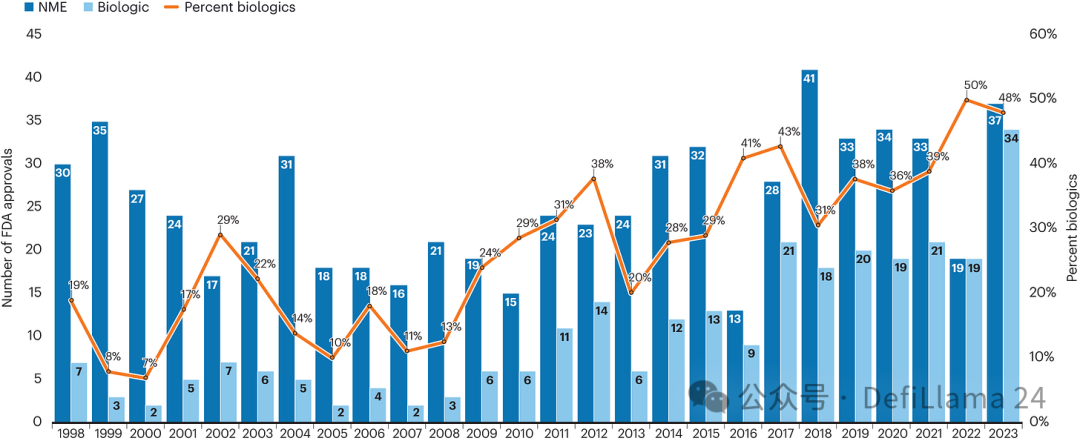 Growth of Biologics Over Time
Growth of Biologics Over Time
But initially, few believed that this new type of drug would become possible. Moreover, there were very few people worldwide with the necessary skills to attempt it. It is easy to overlook the fact that Genentech was initially just a marginal project, with scientists working day and night in matching T-shirts, jeans, and running shoes.
As Peter Thiel noted, the company held an important common secret that the outside world had yet to understand.
Success changed everything. When Genentech achieved its first product breakthrough, the market responded with fervent optimism. Nothing— not even Princess Diana—was more exciting than transforming life.
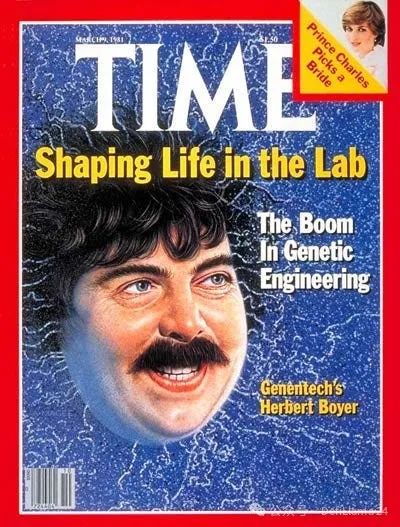
When Genentech went public in 1980, the initial stock price was $35. Within just one hour of trading, the stock price soared to $88, nearly tripling. The scene at that time was one of frenzy.
By 1983, American companies had invested $500 million in emerging biotechnology firms. Two years later, the U.S. Department of Commerce estimated that about 200 biotechnology companies had attracted nearly $2 billion in total investment.
Looking back, this was clearly a speculative bubble. Recombinant DNA technology was still in its infancy. Major breakthroughs like recombinant insulin did not follow quickly. Regulatory issues remained unresolved. Large-scale production of biologics was also a challenge.
The initial boom was followed by a period of disillusionment and contraction. In 1985, a reporter from Massachusetts wrote:
If all this seems too far-fetched for scientists with little or no commercial track record, you are right. Just this point, two trends have dominated the post-boom biotechnology industry.
First, in a few well-capitalized companies, scientist-founders-CEOs are hiring, or being forced to hire, traditional "numbers experts" to serve as company presidents or chief operating officers. These are experienced business executives from large companies, not academics. BioTechnica International in Cambridge just hired a veteran who worked for DuPont for 20 years. At Collaborative Research in nearby Lexington, the new president previously led a subsidiary of Johnson & Johnson. The new president of Damon Biotech in Needham Heights is similarly experienced.
Second, the industry's momentum seems to have shifted in favor of large companies. Especially those that provide substantial seed funding to biotechnology startups through equity purchases and R&D contracts. In a sense, the good response to initial public offerings of new biotechnology companies merely delayed the bad news for many of them. Now, as these young companies desperately need a new round of funding, companies like DuPont, Grace, Monsanto, and Eli Lilly are turning their investments inward toward their own biotechnology capabilities. As a result, industry experts predict a wave of mergers and acquisitions. EF Hutton analyst Nelson Schneider believes that as many as two-thirds of biotechnology companies will either merge or be acquired by large pharmaceutical or chemical manufacturers.
In other words, the industry was forced to mature and truly generate revenue, and existing organizations woke up to begin building their own biotechnology capabilities internally. By the late 1980s, most biotechnology stocks had lost three-quarters of their value.
But at the core of this bubble was an important kernel of truth: recombinant DNA technology is indeed a revolutionary tool for creating new drugs. Even in a more sober environment, companies that had resources, technology, talent, and perseverance continued to launch new products.
After synthetic insulin, Genentech produced seven more biologics throughout the 1980s and 1990s. Amgen was another early pioneer in biologics founded in 1980, which stood out in fierce competition with a series of breakthrough drugs. Regeneron, founded in 1988, established its own identity after the initial boom by conducting in-depth research on the human genome and developing a powerful monoclonal antibody production technology platform—monoclonal antibodies have proven to be one of the most important types of biologics.
Despite many skeptics, the application of biologics continues to expand in the medical field, and by 2022, the number of approvals for biologics finally matched that of small molecule drugs. (As we saw in the previous chart.)
The commercial success of these pioneers is equally undeniable. Genentech was acquired by Roche for $46.8 billion in 2009 and continues to operate as a highly influential independent subsidiary. Amgen is currently valued at $168 billion. Regeneron is now valued at $78 billion, with its stock price rising nearly 4000% since its initial public offering.
This evolution is almost a textbook example of Gartner's hype cycle. The initial "innovation trigger" sparked a massive wave of hype and excitement. When the hype failed to deliver immediately, the market cooled. If the initial trigger had substance, a more gradual recovery would emerge over time.
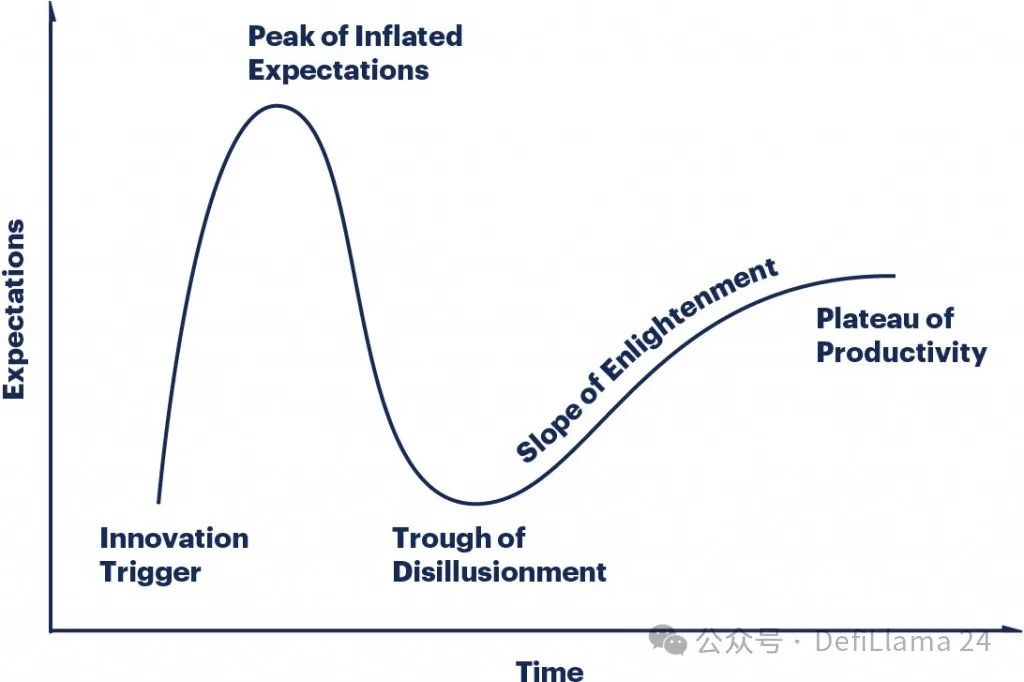
We seem to have indeed entered a "productivity plateau." The ability to produce biologics is no longer a closely guarded secret of a few companies. Scientists around the world have spent decades perfecting the tools to develop these drugs. A large number of companies have emerged, providing antibody development services.
Take Adimab as an example. Founded in 2007, the company utilizes next-generation antibody engineering technology—specifically yeast surface display technology—to rapidly produce new molecules for numerous partners. Currently, they have collaborated with over a hundred different partners, with "more than 75 clinical projects originating from our platform."
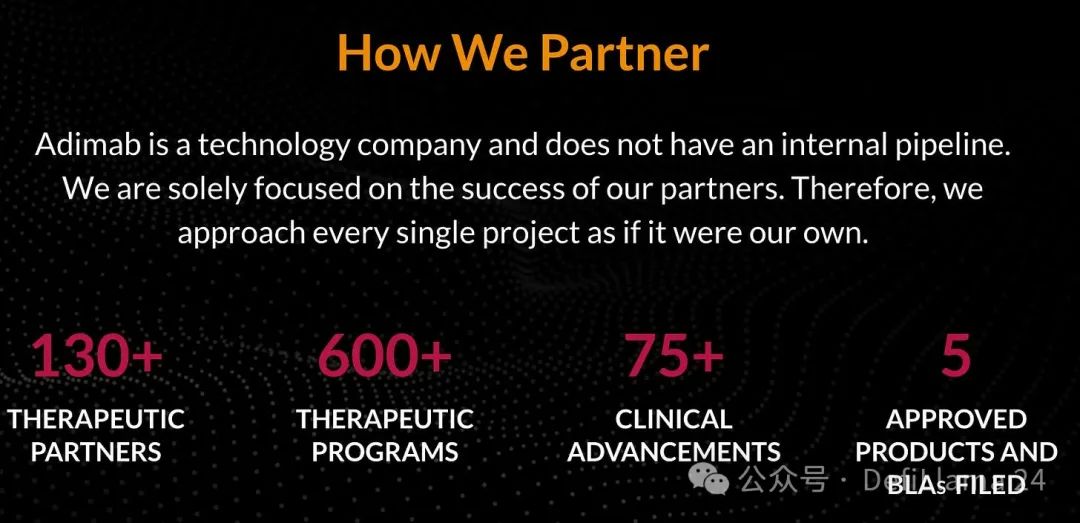 Source: Adimab
Source: Adimab
Given that Adimab is a private company, it is difficult to directly compare its commercial success with pioneers like Amgen or Regeneron. However, based on a valuation of $1.1 billion from a secondary transaction ten years ago, it has roughly grown into a company valued at around $5 to $10 billion.
Today, if a company wishes to adopt different technologies or has specific preferences regarding cost, speed, geographical location, or various other factors, they can choose to collaborate with FairJourney Biologics (valued at approximately $900 million in 2024), OmniAb (market cap around $400 million), Ablexis, Specifica, Creative Biolabs, Twist Biosciences, Alloy Therapeutics, or other companies. This list is merely illustrative and far from exhaustive.
It is noteworthy that the scale of each generation of companies has roughly decreased by an order of magnitude. Pioneers grew into companies valued at over $100 billion, the subsequent leading service providers became companies valued at over $10 billion, while the new entrants discovering the market today are companies valued at over $1 billion.
In my view, this resembles the textbook definition of commercialization, which is the gradual transformation of goods or services into commodities and the ensuing competition on price. Commodities refer to goods or services that can be exchanged for other similar goods.
Think about electronic products. Initially, only a few companies could produce the best televisions, and these companies charged a high premium. Over time, this premium was eroded by competition. Today, numerous companies sell large flat screens with smart features for hundreds of dollars at Costco. This is the process of commoditization.
Similarly, the differences between antibody discovery service providers are becoming increasingly difficult to distinguish, as many companies use similar technologies to produce antibodies targeting the same drug targets.
So far, we have only focused on the history of antibodies. But I would like to boldly hypothesize, which may annoy some drug developers: no discovery technology is immune to the inevitable trend of commoditization—just like almost all other technologies.
For both small and large molecules, once a discovery technology—whether high-throughput screening, computational modeling, in vitro or in vivo models, or analytical detection—becomes standardized, companies around the world will compete to offer it as a service.
This is the long journey of modality commoditization.
Over time, revolutionary ideas become the common foundation for the next wave of innovation.
Strategic Evolution in Biotechnology
As discovery technologies become standardized and commoditized, biotechnology investment is also becoming more specialized. After decades of refinement, the industry is trending towards adopting standardized company valuation models and emerging new strategies.
One widely recognized strategy is the "fast follower" approach, which involves developing a new drug to become the "best in class" on targets already addressed by existing drugs, rather than being the "first in class" on entirely new drug targets.
An analysis published in 2003 highlighted two key advantages of "pursuing the best." First, such drugs clearly exhibit lower risk characteristics, as their targets have been validated through human evidence-based drug approvals. Investors often discuss the degree of "biological risk" they assume for new target hypotheses. Second, the risk differential does not seem to yield corresponding rewards. In fact, an observation of drugs launched between 1991 and 2000 shows that most blockbuster drugs were developed for known targets, while the value created by fast followers exceeded that of higher-risk innovative drugs.
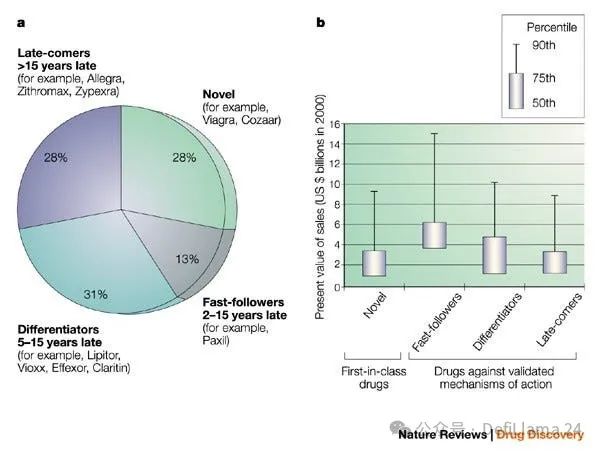 Pursuing the Best
Pursuing the Best
Merck's acquisition of the oral GLP-1 agonist we previously studied is a vivid example of this strategy. Novo Nordisk and Eli Lilly took on significant risks in validating the efficacy of the first GLP-1 drugs. Today, other companies are racing to develop fast-following products with improved characteristics, such as replacing injections with oral formulations.
Many biotechnology investors have pushed this analysis to its logical extreme. As the scale of early financing rounds and the capital behind them have expanded, it has become increasingly difficult to justify placing large bets on completely unproven target hypotheses. In practice, this has led to severe clustering in validated target areas.
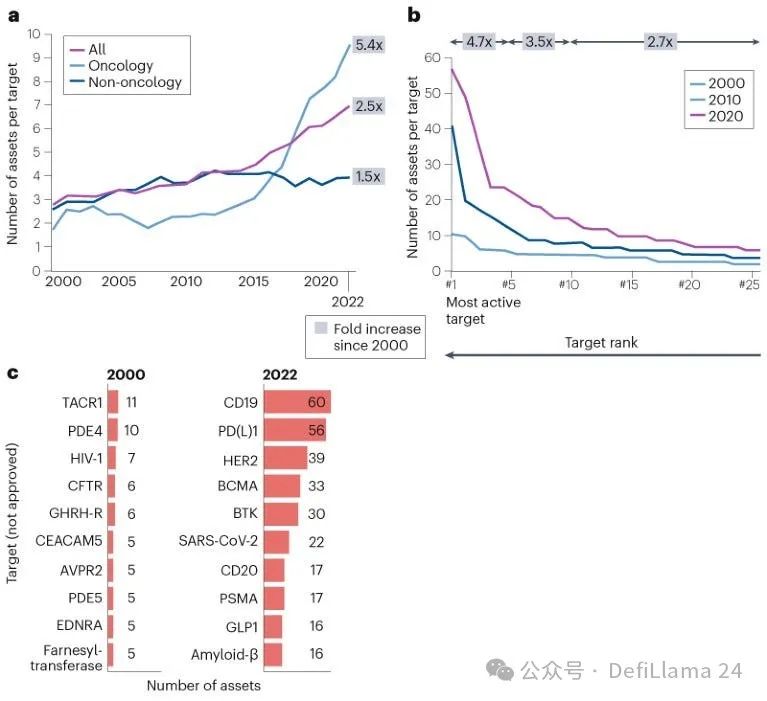 Clustering Phenomenon in Drug Development Pipelines
Clustering Phenomenon in Drug Development Pipelines
To make things more efficient, "virtual biotechnology companies" emerged around the 2010s, outsourcing all R&D work to discovery partners like Adimab. Their goal is typically to rapidly develop the best molecules targeting known targets and then sell them to large pharmaceutical companies for later development and commercialization.
This segment of industry history is crucial for understanding the recent surge in licensing agreements from China, as many top outsourcing partners are Chinese contract research organizations (CROs).
WuXi Biologics, a Chinese giant providing comprehensive biologics discovery and manufacturing services, has risen to become the second-largest outsourcing partner globally, capturing over 10% of the global market share.
Today, China's logical strategic evolution reflected in the new policies of 2015 is shifting from being purely a service provider to independently developing drugs. In a world where most are using standardized discovery technologies targeting the same drug targets, China has two key advantages:
Speed. A new series of reforms has enabled clinical trials to be initiated more quickly.
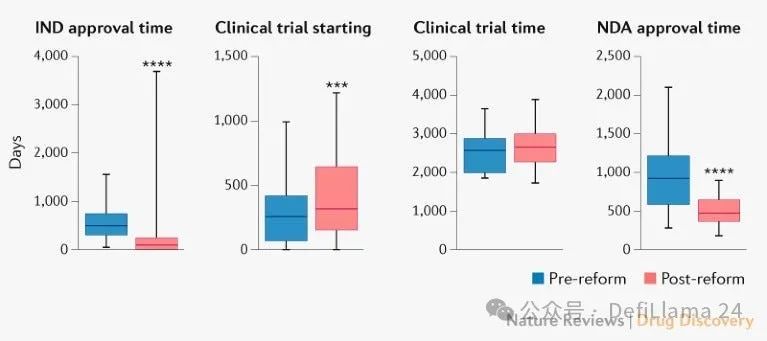 Trends in Innovative Drug Development in China (Thanks again to Alex Telford's excellent blog post for bringing this data to my attention!)
Trends in Innovative Drug Development in China (Thanks again to Alex Telford's excellent blog post for bringing this data to my attention!)
Cost. The salaries of Chinese scientists are only a fraction of those of American scientists. An army of highly skilled researchers—often trained in the U.S.—can be deployed to investigate more issues.
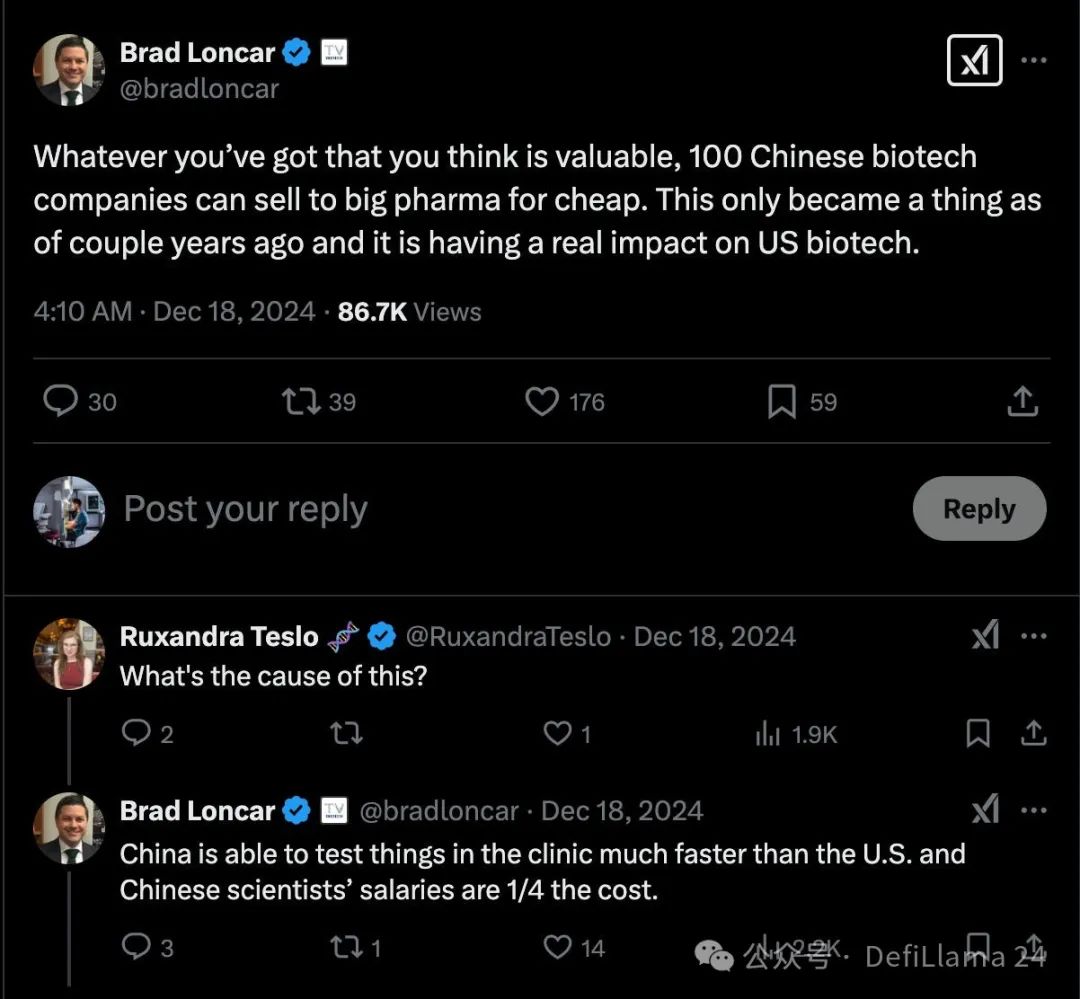
With these advantages, Chinese startups and biopharmaceutical companies seem to have covered the field of known drug targets. Companies are laying out cheap "call options" on a wide range of targets in the form of preclinical or early assets. When a specific target or product concept gains favor with a large pharmaceutical company, these "options" can be executed by accelerating existing project progress through increased investment.
This puts immense pressure on the fast follower strategy. While American scientists sleep at night, the machines in competitor labs on the other side of the globe are still buzzing away.
So far, we have traced the history of the commoditization of drug discovery technologies and the subsequent specialization of biotechnology investment. These changes help provide context for the industry's "DeepSeek moment."
Now, let’s think about the areas where future value may accumulate.
Artificial Intelligence May Be the Last Wave of Commoditization
In recent years, a significant amount of funding has flowed into ambitious companies aiming to leverage artificial intelligence to transform drug development. Companies like Xaira Therapeutics, which started with $1 billion in "seed" funding, aim to independently develop drugs. However, many companies such as EvolutionaryScale, Profluent, Chai Discovery, and Latent Labs prefer to adopt a strategy similar to Adimab, providing this new technology as a broadly empowering infrastructure.
When Latent Labs was founded, Pillar's Tony Kulesa wrote:
This gave birth to a clear vision: to popularize the use of advanced AI tools in the field of drug discovery. While every biotechnology and pharmaceutical company searching for therapeutic molecules understands the role of AI, most do not have the capability to develop their own cutting-edge models and tools. Simon's insight is that by allowing partners to access the best tools instantly, Latent Labs can accelerate the drug design process across the entire industry.
The combination of large-scale financing and new business models has triggered a complex reaction of curiosity and skepticism. Endpoints' Andy Dunn wrote, "The establishment of Latent demonstrates how AI-centric startups can disrupt the traditional biotech landscape. Most biotech companies are formed around a molecule, research paper, or key intellectual property, while Latent's investors are betting on the AI talents of Kohl and another former DeepMind developer, Alex Bridgland, believing they can find a way forward."
Let’s consider the bear and bull market scenarios for this investment thesis.
In a bear market scenario, compared to commoditized technologies, whether focusing on new data generation, model scaling, architectural improvements, or some combination of the three, these technological directions may not significantly drive progress.
In the on-site notes from the MIT Molecular Machine Learning Conference, Dimension's Simon Barnett wrote: "My understanding of [Adimab co-founder] Dr. Wittrup's talk is that he believes monoclonal antibody (mAb) discovery is essentially a solved problem, and the impact of machine learning (ML) on this field is overstated."
If AI technology ultimately has only a minor quantifiable impact on issues like antibody discovery, companies providing these solutions may join the ranks of many competitors offering such services. We might see companies with valuations below $1 billion, rather than generational giants valued at around $50 billion to $100 billion or more.
What about the bull market scenario? Squint your eyes and imagine that the trajectory of AI advancements will lead to a qualitative leap, truly ushering us into a world of design rather than discovery. Imagine a model that can predict Platonic antibodies with zero samples—perfect affinity and specificity for any target, optimized to the extreme in every dimension. Input the target product profile (TPP), and you get a drug.
That could be a big deal.
A commonly cited comparison is Cadence Design Systems, a company with a market capitalization of $66 billion, most of whose revenue comes from licensing its electronic design automation (EDA) software and intellectual property to the semiconductor industry. In high-value areas, the best design tools can be extremely valuable. So, will the "Cadence of the pharmaceutical industry" be even larger?
Is there evidence to support this trajectory of technological development?
In March of last year, the Baker Lab at the University of Washington published a preprint paper titled "Atomic Precision De Novo Design of Single-Domain Antibodies." Building on decades of leading work in computational protein design, they introduced an AI model capable of effectively generating mini-antibodies (known as VHHs or nanobodies) for specific targets.
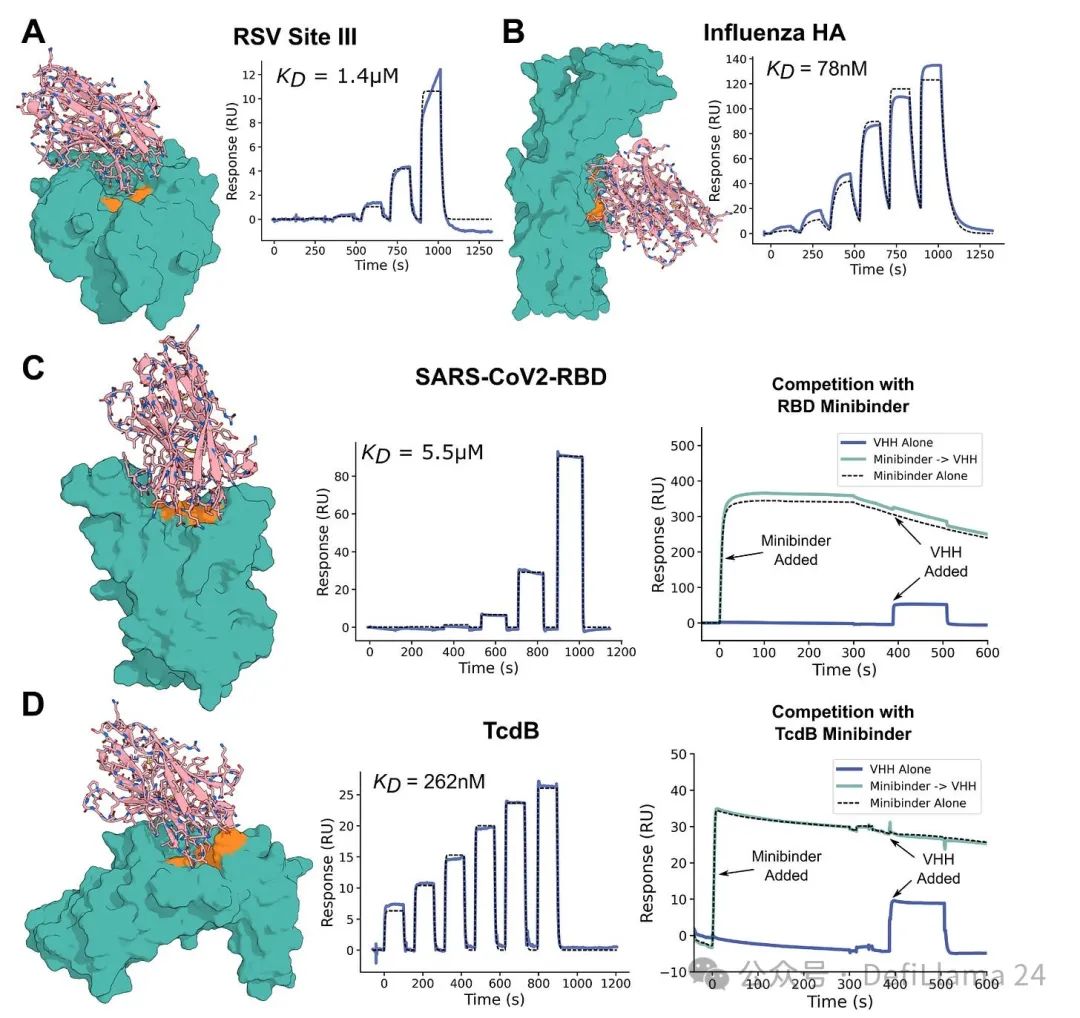 Figure 2 Part Content: Atomic Precision De Novo Design of Single-Domain Antibodies. The binder is shown in pink, and the target protein is in cyan. The specified epitope (the area where the antibody binds) is shown in orange.
Figure 2 Part Content: Atomic Precision De Novo Design of Single-Domain Antibodies. The binder is shown in pink, and the target protein is in cyan. The specified epitope (the area where the antibody binds) is shown in orange.
These results sparked tremendous excitement and interest—including a $1 billion bet to launch Xaira. However, this work was merely a proof of concept, not a magical black box that can spit out perfect antibodies. Scientists noted that the generated nanobodies still had too weak an affinity for their targets to be considered drugs. Moreover, nanobodies are a peculiar type of protein that does not fully resemble human antibodies—again limiting their utility in many clinical applications.
Less than a year later, the Baker Lab "significantly updated" their initial preprint, renaming it "Atomic-Level Precise Antibody Design from Scratch Using RFdiffusion." As you might guess, the title was changed because the scope of the research expanded beyond VHH design. The updated preprint also showcased the design of single-chain variable fragments (scFvs), another form of antibody that has two variable domains instead of the single variable domain of VHHs.
Another important update addressed the affinity issue. The authors wrote, "While the initial computational designs showed generally low affinities, affinity maturation using OrthoRep can produce binders with single-digit nanomolar affinities while maintaining the desired epitope selectivity." In other words, AI currently cannot generate perfect binders, but it can rapidly adjust and optimize them using existing experimental techniques.
So, this is about a year's time. Risking drawing a line between two data points, progress seems quite rapid. Looking ahead, what if someone uses OrthoRep to create a massive affinity training dataset, and this step moves out of the atomic realm, encoding improvements in model weights in the world of bits?
What will hinder the continued development from VHHs to scFvs and then to mature monoclonal antibodies over the next five years?
Again, a rough observation suggests that we are on the brink of digitizing biopharmaceutical development. If the advantages in speed, cost—and possibly quality—are significant enough, this could lead to the consolidation of the discovery market, with new entrants quickly attracting a large share of outsourced work, replacing existing companies.
Now, let’s seriously consider what the world under the concept of "foundation models" might look like. What if the important foundational patterns of biological structure and function are learned through multi-task learning? As Simon Kohl of Latent Labs said to Endpoints, "This vision is grander. I believe we can expand on this, and over time, we will find many other areas beyond molecular interactions that can also be guided by generative models."
Therefore, if this point—or any part I just outlined—is true, some of these companies could become very large.
But one of the biggest threats is likely… commoditization! After all, the entire framework of the "deepseek moment" stems from Chinese research teams achieving a sudden leap in AI capabilities with fewer resources than their American counterparts.
There are already signs of this.
So far, Demis Hassabis, co-recipient of the Nobel Prize in protein structure prediction and CEO of DeepMind and Isomorphic Labs, has been betting on algorithmic innovation rather than building proprietary data moats to ensure model defensibility. In a recent interview, he stated, "Make your algorithms better, make your models better. You really have enough data—as long as you are innovative enough in your algorithms."
It is surprising how quickly serious algorithmic competitors have emerged.
In May 2024, Isomorphic and DeepMind published a paper introducing their latest and most advanced structure prediction model, AlphaFold3. In September of the same year, Chai Discovery released and open-sourced a cutting-edge model. About two months later, a research group at MIT launched another open-source version with comparable performance.
In this new AI race, how value will accumulate is worth watching.
In any case, all these advancements will open up new opportunities for innovation in drug development and other areas.
Discovery Platforms May Become More Valuable
Not all biotechnology platforms focus on therapeutic modalities. Some companies are concerned with the other side of the coin: identifying new biological targets for drug development. In Steve Holtzman's "Typology of Platform Companies," these are referred to as "insight platforms."
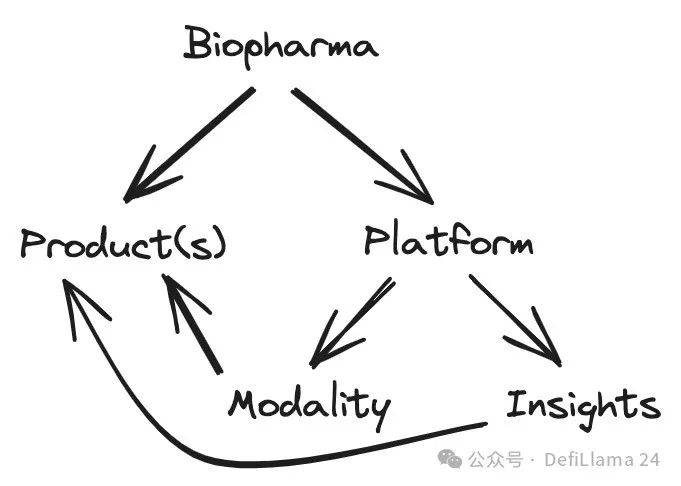 About Biotechnology Platform Strategy
About Biotechnology Platform Strategy
Focusing on disease insights also comes with a series of strategic challenges. Holtzman wrote in his original post:
However, Type 2A platform companies face a series of challenges that Type 1 platform companies have not encountered. These challenges essentially stem from the fact that the output of Type 2A platform companies is data/information/insights, rather than producing new chemical entities (NCEs) and biologics like Type 1 platform companies.
- The data history of the biopharmaceutical industry is its history of commoditization.
- Companies that rely on drugs/products as their "lifeline" have vested interests in "pre-competitive" data (or at least doing so after a period of exclusivity). They win with products; they are unwilling to be constrained by information owners.
- The intellectual property (IP) environment is becoming increasingly stringent: the days when one could obtain patents for logical forms like "methods of modulating target A to treat disease X by any means" based solely on demonstrating the overexpression of a certain gene in diseased tissue (or gene mutations in disease states) are long gone (with claims stating that "means" could be antibodies, antisense nucleic acids, RNA interference, gene therapy, small molecules, etc.).
- Furthermore, over time, the demands of the customer base have become broader. In the 1990s, most large pharmaceutical companies were willing to accept terms that limited data use to small molecule drug discovery and development (since that was the only area they operated in), whereas now, all pharmaceutical companies/large biotech companies demand rights to use this data for all therapeutic modality development.
- Finally, Genus 2, Species A platform companies have built their expertise in data generation, management, and analysis. They do not possess or cannot afford significant capability investments in drug discovery/development in one or more therapeutic modalities or in-depth biological/translational capability cultivation in one or more disease areas.
- The end result: Genus 2, Species A platform companies abandon their data/information business and instead establish and become drug discovery and development enterprises.
Let’s break this down.
First, it is important to recognize that the data generation technology itself has also undergone a long process of commoditization. (This is technology, folks!) Second, the main issue in the past was the asymmetric negotiations with large partners—they had exclusive access to discovery technologies, giving them an unfair advantage when it came to actually creating chemical entities targeting new targets.
This dynamic has begun to shift. The growth and maturation of the CRO industry have enabled insight companies to participate in partner discussions with their own new chemical entities (NCEs) rather than just patents around target insights.
What if AI accelerates this dynamic? Over time, as modalities become increasingly commoditized, the time and cost from target insights to developable chemical entities may be further compressed.
In this world order, the scales may tip. New disease insights targeting known targets may hold value that surpasses any incremental starting point in chemical space.
After all, the success story of GLP-1 drugs exceeding $100 billion is built on biological insights, not advancements in technological modalities.
Several economic and technological realities may slow progress in this area.
Economically, as David Yang astutely pointed out, the reason GLP-1 became a success story for the pharmaceutical industry rather than a victory for biotech companies is partly due to the core role of mergers and acquisitions in the industry. Most early biotech investors hoped to achieve liquidity through large acquisitions, meaning they closely monitored the acquisition lists of pharmaceutical giants. Pharmaceutical buyers are indeed reluctant to spend billions to validate new biological hypotheses—especially when the scale of market opportunities is unclear.
How do we change this status quo and unleash a new wave of more innovative drugs? We need to continue shortening the time and cost at every stage from discovery to development to commercialization.
Doing so will make early drug discovery more valuable.
Enhancing discovery and commercialization capabilities seems to be a technological issue. Accelerated development may require new technologies and regulatory reforms. Learning from China's experience (let's switch it up this time!) and studying its recent reform initiatives may provide a good starting point for the latter.
Technologically, it is important to recognize that simulating human biology is a more challenging AI problem than simulating specific modalities. Consider two questions: Does my antibody bind this target with higher affinity? What impact does activating the GLP-1 receptor have on the physiology of the entire human body? Tools that can clearly answer the first question are already available in the lab. The answer to the second question can only be fully known after the first human trials, as our preclinical models are merely rough approximations of human biology.
More effectively simulating human biology may require extensive data generation and ongoing advancements in new AI paradigms.
Over time, addressing these economic and technological challenges could significantly reshape the landscape of the biopharmaceutical industry, leading a wave of emerging commercial biotech companies to advance bold new therapies.
But in the long run, all these rapidly accumulating technologies may also lead to a more thorough divergence from traditional biotech business models.
Moats May Be Very Different
In most industries, there are various viable strategies to establish a lasting competitive advantage. The classic 7 Powers framework proposed by Hamilton Helmer aims to enumerate the most commonly adopted methods.
The 7 Powers are:
- Economies of scale—companies that experience a decrease in unit costs as production increases.
- Network economy—a business model where the value realized by customers increases as the user base expands.
- Reverse positioning—companies adopting a new, superior business model that existing companies cannot emulate due to fears of their current business being eroded.
- Switching costs—a business model where customers expect to incur losses greater than the value gained by switching to alternatives.
- Brand effect—due to the influence of historical information, a company enjoys a higher perceived value when offering objectively the same products or services.
- Constrained resources—a company has preferential access to a coveted resource that can independently enhance value.
- Process power—an organization’s structure and activity mix can achieve lower costs and/or higher quality products, with these advantages only being matched through long-term investment.
Risking oversimplification, in the biopharmaceutical field, only two forces are truly important. Large pharmaceutical companies benefit from economies of scale, as they can spread the costs of development and commercialization across the revenues from their existing product portfolios. For biotechnology companies, the only real source of power is essentially the monopoly resources controlled in the form of new intellectual property (IP).
As Peter Drucker once wrote, "The pharmaceutical industry is an information industry." The value of small molecule drugs is unrelated to their physical form, which is nearly worthless. The ability to charge the highest profits for any existing tangible product is purely a function of intellectual property. Once the IP expires, generic manufacturers can quickly enter the market, offering significantly reduced prices.
This is what Peter Kolchinsky of RA Capital defined as the "biotechnology social contract." Scientists and entrepreneurs are rewarded with patent exclusivity for their innovations. But this exclusivity is limited. Once it expires, innovative drugs become affordable commodities for future generations.
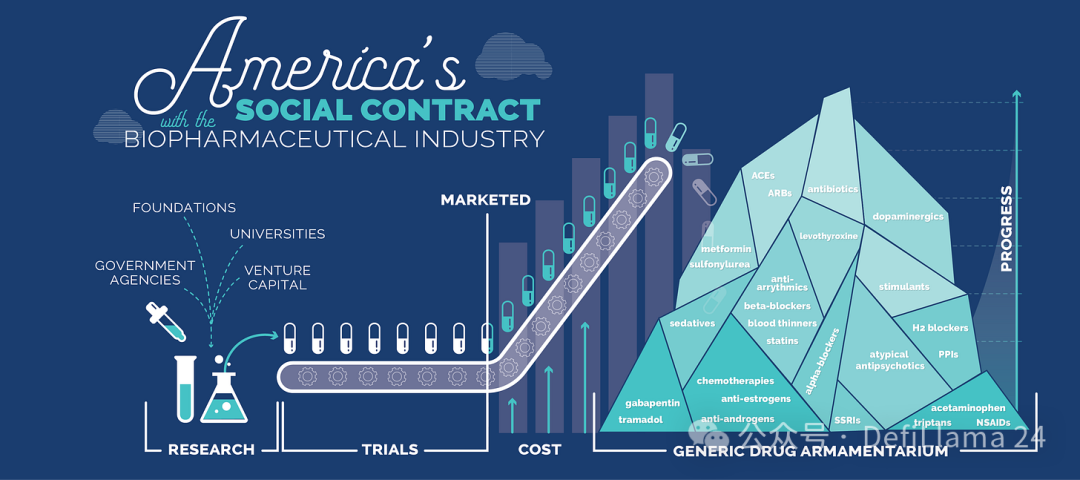
Source: The Social Contract Between the U.S. and the Biopharmaceutical Industry
The concern brought by commoditization is that this may soon become the social contract between China and the biopharmaceutical industry—as long as they can produce products with equivalent intellectual property at lower costs and faster speeds.
But what if there were a different way to establish defensive barriers in the biotechnology field?
Some early examples point to defensive orthogonal forms. For CAR-T therapy—a new medical form centered on modifying patients' own cells to eliminate cancer—what its generalization will look like remains uncertain. Kolchinsky expressed concern about this in his book on the "biotechnology social contract." Companies selling these drugs may derive their moats from process power rather than monopoly resources surrounding intellectual property.
Now let’s move forward in time.
Personalized cancer vaccines are another treatment method with such a form. The core of these drugs is not a single chemical component. Instead, each dose is made through a complex combination of patient measurement data, algorithms, and production steps.
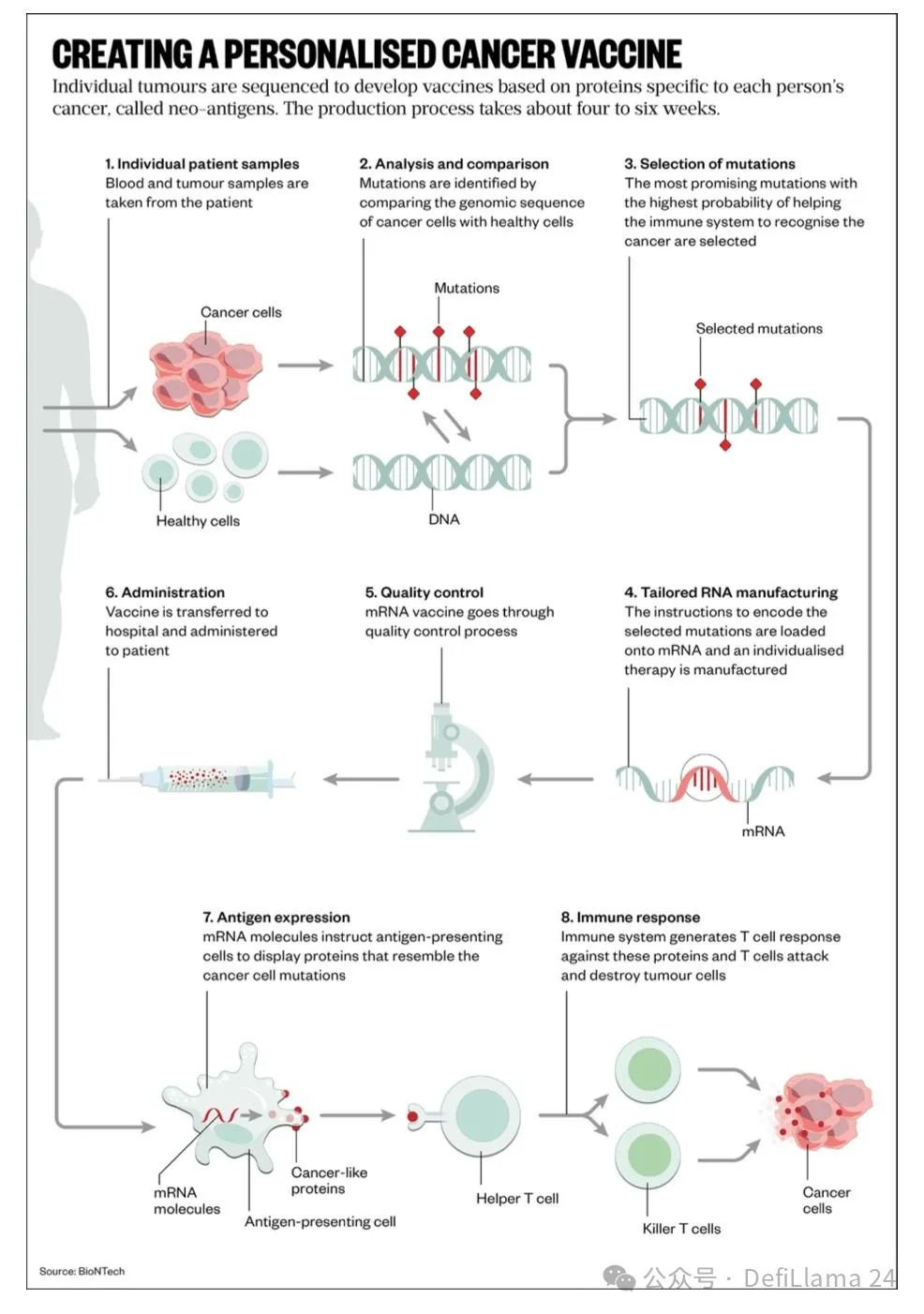
This brings about very interesting consequences. This may be the first drug with network economy effects. Since each dose is designed through algorithms, its quality can improve as more data is collected. Patients can benefit from drugs produced by companies with the largest data barriers. This approach clearly also benefits from process power. Over time, as market leaders, the winners of this new model may even accumulate significant brand advantages.
If more forms of drugs begin to exhibit this trend, we may see a wave of biotechnology companies directly competing to establish themselves as a new generation of pharmaceutical companies.
Thinking of this, I can't help but recall my friend Packy McCormick's discussion about vertical integrators. In his words, these companies have several decisive characteristics:
Vertical integrators are those that:
- Integrate multiple cutting-edge and validated technologies.
- Develop significant internal capabilities within their technology stack.
- Modularize standardized components while controlling overall system integration.
- Compete directly with existing industry giants.
- Offer higher quality, faster, or more economical products (often all three).
For vertical integrators, integration itself is innovation.
As always, this strategy faces obvious challenges. There’s no such thing as a free lunch!
A significant barrier is likely financing and capital formation. The way these companies are created is entirely different from how most biotechnology investors consider generating returns. It is currently unclear whether large pharmaceutical companies would be willing to acquire companies with such complex products without clear proof of commercial viability.
Winners in this field may need to seek alternative funding sources. A viable option is to tap into the growing pool of "deep tech" venture capital, which focuses on supporting breakthrough advancements in hardware and innovations in the atomic world. Later-stage investments may come from comprehensive growth equity firms rather than traditional biotech crossover funds.
Attempting to build vertical integrators in the biotechnology field is not for the faint of heart.
Integrating multiple technologies in new ways is no easy feat. Financing will be challenging. Expanding commercialization efforts is equally difficult. Success may take far longer than expected.
Given all these factors, biotechnology investment may begin to reflect the overall evolution trend of the private equity market. Companies may extend their time in a privatized state. Take SpaceX as an example; this company raised nearly $10 billion during its 23 years of privatization and is now valued at $350 billion. The liquidity for early investors and employees primarily comes from secondary markets rather than merger transactions or initial public offerings.
Despite the challenges, the potential rewards are enormous.
Once unimaginable measurement tools are now commonplace in the field of biology. The foundational insights that birthed the last wave of biotechnology have been refined and commoditized. Artificial intelligence is accelerating the shift of biology toward predictive and quantitative disciplines.
Addressing significant issues like cancer, infectious diseases, and brain health—previously difficult for traditional methods—may require innovative solutions that integrate various digital and physical building blocks.
If these companies solving global problems establish moats in new ways, we may witness the birth of the first biotechnology companies with market capitalizations exceeding $1 trillion.
The current state of the public biotechnology market is quite bleak. For U.S. biotechnology companies, the ongoing surge in Chinese acquisition activity further threatens their prospects for success. As Adam Feuerstein wrote, "Market sentiment is terrible, and the pessimistic atmosphere is so pervasive that people are starting to seriously question whether the industry has any chance of a turnaround."
Meanwhile, the early market is full of potential. The pace of technological innovation is equally rapid. Entrepreneurs who have learned valuable lessons and mastered powerful tools are pursuing entirely new ideas.
Perhaps the right question is not whether the market will rebound. Because it will eventually rebound. Markets are cyclical. Instead, the question is whether biotechnology is on the verge of transitioning to a new phase. If so, now is the best time to start a business.
In other words…
Biotech is dead. Long live biotech!
免责声明:本文章仅代表作者个人观点,不代表本平台的立场和观点。本文章仅供信息分享,不构成对任何人的任何投资建议。用户与作者之间的任何争议,与本平台无关。如网页中刊载的文章或图片涉及侵权,请提供相关的权利证明和身份证明发送邮件到support@aicoin.com,本平台相关工作人员将会进行核查。




